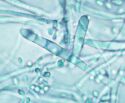Trichophyton
The Innate Immune Response
Immunity to Trichophyton is acquired by active infection. Since Trichophyton infects the epidermal layer of the skin, the constant turnover of the layers is one way to protect against further spread of infection. Thus the turnover is constantly pushing the infected cells to the surface, which is one reason why the only the layers beyond the stratum corneum are rarely breached and infected. Other non-specific factors that could inhibit the fungal growth are hydration of skin and the specific location and condition of the location where the infection occurred in the stratum corneum (Dahl & Carpenter 1985). Another innate response is unsaturated transferring named “serum inhibitory factor” that binds free iron and thus removes the pathogen’s nutrients (Dahl and Grando 1994).

Figure 3. Microscope image of Trichophyton rubrum. In attempt to counter the long fibrils of the Trichophyton organism, shown here in the image above, the human body uses several non-specific methods. One such method is how the epidermis continually has a high turnover rate to control fungal penetration into the dermis, where infection would have more devastating consequences. (Permission pending http://www.scientificpsychic.com/health/hygiene.html)
Evasion of Immune System Detection
Prevention & Treatment and Future Research
For more information, please refer to the
Davidson College Biology Home Page
E-mail me any comments or concerns
© Copyright 2007 Department of Biology, Davidson College, Davidson, NC 28035